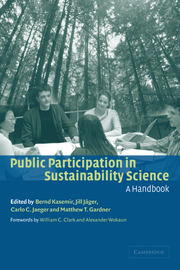Book contents
- Frontmatter
- Contents
- Notes on contributors
- Foreword: science, participation, and sustainability
- Foreword: sustainability, energy use, and public participation
- Preface
- Acknowledgments
- Part I Concepts and insights
- Part II Experiences with IA Focus Groups
- Introduction
- 4 Collage processes and citizens' visions for the future
- 5 Citizen interaction with computer models
- 6 Citizens' reports on climate strategies
- Part III Further forms of participation
- Part IV Future perspectives
- References
- Index
Introduction
Published online by Cambridge University Press: 22 September 2009
- Frontmatter
- Contents
- Notes on contributors
- Foreword: science, participation, and sustainability
- Foreword: sustainability, energy use, and public participation
- Preface
- Acknowledgments
- Part I Concepts and insights
- Part II Experiences with IA Focus Groups
- Introduction
- 4 Collage processes and citizens' visions for the future
- 5 Citizen interaction with computer models
- 6 Citizens' reports on climate strategies
- Part III Further forms of participation
- Part IV Future perspectives
- References
- Index
Summary
The second part of this book concerns procedures for citizen participation in sustainability science, and results obtained from such participatory procedures. As in Part I on Concepts and Insights, also in the research discussed in Part II, the issue of climate change and its relation to urban lifestyles is used as a case study to examine the possible roles of public participation in sustainability science. In order to allow a meaningful interaction between lay and expert perspectives in participatory procedures on this issue, these IA Focus Groups with citizens consisted of three distinct phases. Experiences with collage processes in the first phase of IA Focus Groups, allowing participants to express their spontaneous feelings on the focal topic of climate change and energy use, are discussed in Chapter 4 by Kasemir et al., and illustrated with examples of collage pictures. Findings include the fact that citizens across Europe saw a future with strongly reduced energy use rather positively, more so than might be found, for example, in a US context. In making collages, the citizens were found to be rather sophisticated in dealing with ambiguity and uncertainty. In Chapter 5, Dahinden et al. discuss the use of computer models in the second phase of IA Focus Group procedures. These models were found to be powerful tools for promoting insights about complex sustainability issues like climate change, but future models could be improved, in particular with regard to accessibility to lay audiences.
- Type
- Chapter
- Information
- Public Participation in Sustainability ScienceA Handbook, pp. 79 - 80Publisher: Cambridge University PressPrint publication year: 2003
- 1
- Cited by

